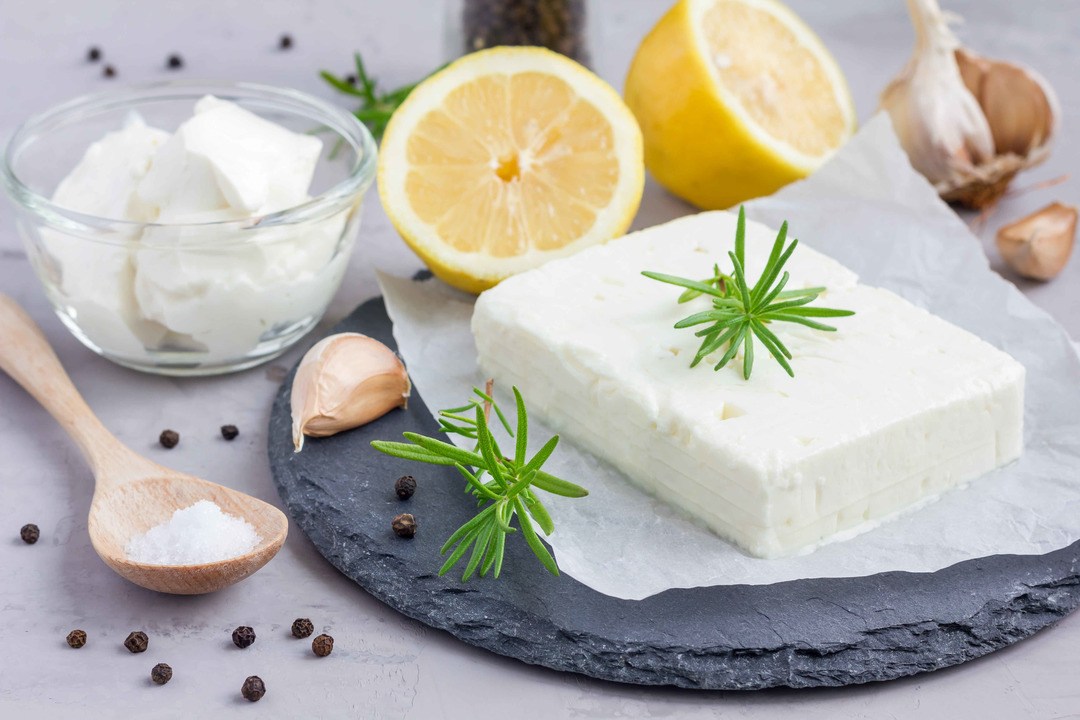Originating from Greece, Feta cheese is a type of curd white cheese that usually comes in a block form. It’s either sourced from sheep’s milk or a combination of sheep and goat’s milk (usually unpasteurized).
To tell it apart from other cheeses, know that it has a crumbly, grainy texture. There are also some variations in its production – so, you will find soft varieties as well as semi-hard ones.
Feta cheese is a versatile type of cheese – that’s why many people love it. You can use Feta in pizzas, sandwiches, omelets, salads, and more.
More...
Can You Freeze Feta Cheese?
Quick answer: Yes. The truth is – Feta cheese freezes well and can maintain its quality and texture even when frozen.
Whatever your reason is for wanting to freeze Feta cheese, know that it comes with some dos and don’ts. Surely, you’d want to freeze it properly in order to come back to a delicious and high-quality Feta that’s still safe (and enjoyable) to eat.
Don’t worry, I will cover everything you need to know about freezing Feta in this article.
You May Be Interested: Guide To Freezing Your Ricotta Cheese
What Feta Cheese Tastes Like
You need to know how Feta cheese tastes like so as to be able to tell if its quality is still good after freezing it. Although the process of freezing can make the cheese lose some of its flavors, its basic taste will still (and should still) remain the same.
Feta cheese has a high salt content – that’s why it’s really quite salty in taste. We can say that it’s saltier in taste when compared to other types of cheese – since it’s brined in a solution of salt to keep it fresh.
Feta Cheese Texture
It’s also important to know the consistency and feel of Feta cheese to be able to assess its quality. While fresh Feta has a crumbly texture, it will be even crumblier when frozen and thawed.
The change in its texture really doesn’t affect its taste and quality – because like I said, it’s one of those cheeses that freezes well. However, you might not be able to slice it into cubes when it’s already too crumbly.
When too crumbly, just use the cheese in recipes that call for crumbled Feta – like salads. It will still melt well, so it’s also suitable for use in saucy dishes and as pizza toppings.
How to Freeze Feta Cheese
Perhaps, this is the most important section of this post, as I will cover the steps on how to freeze Feta cheese properly here. If you follow these steps, your thawed frozen Feta cheese will still be as good (or almost as good) as fresh Feta cheese.
STEP 1 | If your Feta cheese came with brine, drain it first. |
STEP 2 | Get a paper towel and gently pat the cheese dry. |
STEP 3 | If you’re freezing a lot of Feta cheese, consider packing them in batches. Doing so will allow you to use a small pack of cheese without thawing everything and then freezing the leftovers again (this is not advisable). |
STEP 4 | Place the Feta cheese in freezer-safe containers. |
STEP 5 | If you’re using Ziploc bags, remove the air from the bags before sealing them. |
STEP 6 | Label the bags/ containers with dates on when you placed the Feta cheese in the freezer. |
How to Thaw Frozen Feta Cheese
Following the proper thawing process will allow you to maintain the quality, taste, and texture of the fresh Feta cheese you put inside the freezer.
STEP 1 | If you’re planning to use your frozen Feta cheese the next day, thaw it in the refrigerator overnight. |
STEP 2 | Keep the frozen Feta cheese in its wrapping or container while it’s being thawed in the fridge. Removing it from the wrapper or container will cause it to dry out. |
STEP 3 | When fully thawed, taste the cheese to check on its flavor. |
STEP 4 | If the taste is too bland, make a homemade brine by combining a mixture of water and salt. Soak the Feta cheese in this solution for a few hours (to regain its original salty taste). |
STEP 5 | If you find the Feta cheese too crumbly to maintain its form, use it in recipes that call for crumbled or melted Feta. |
Signs that Feta Cheese is Still Good After Freezing
Even if you have properly stored and frozen Feta cheese, it could still get spoiled. To make sure that it’s still good and safe to eat, check on the following points:
- No signs of mold – If you see mold on the Feta cheese, it’s already contaminated. In this case, just throw it away as eating it can make you sick.
- Taste is still the same – Thawed frozen Feta should still taste good. Even if it loses some of its saltiness, the overall taste should still be the same. If you sense some weird (bad) taste, don’t eat it – it has probably gone bad while in the freezer.
- Smell should be the same – The smell of thawed frozen Feta should still be the same as that of fresh Feta. Any unpleasant smell (especially sour smell) is an indication that the cheese is already spoiled. In this case, don’t use it and just discard it.
Feta Cheese Tips
Here are some things to keep in mind when storing, freezing, and thawing Feta cheese:
- Once you have frozen and thawed Feta cheese, use it immediately. Don’t freeze it again as it has already been exposed to room temperature and has become a breeding ground for bacteria.
- Fresh Feta cheese should be consumed within 3 days (when not frozen or submerged in brine).
- Frozen and thawed Feta cheese is best used in recipes that would expose the cheese to very high heat (for it to melt). You can also use crumbled Feta cheese in salads.
- For best results, don’t freeze Feta cheese for more than a month.
- When kept in a brine solution, Feta cheese can last in the refrigerator for about a month.
- Always check on the best before date to make sure that the Feta cheese is in its best condition when you purchased it.
Benefits of Eating Feta Cheese

Feta Cheese
Knowing about the nutrition facts of Feta cheese (video) will further increase your knowledge about this type of cheese. To find out if you should really include Feta in your daily diet, consider the points listed below.
- Good for bone health – Feta cheese is high in calcium, protein, and phosphorous – which all contribute to having strong bones and teeth. As far as calcium is concerned, Feta cheese is a better source of this mineral than other types of cheese (Ricotta, Mozzarella, Cottage, Goat cheese, etc.).
- Good for the heart and weight – Since Feta cheese is low in calories and fat, this will not contribute to your weight increase. In fact, when compared to other popular types of cheeses like Cheddar and Parmesan, Feta has lower fat and calorie content.
- Good for the digestive system – Feta cheese carries live friendly bacteria that work in protecting the intestines from damages. These bacteria can even serve the purpose of protecting the body from being affected by E. Coli and Salmonella.
- Rich in vitamins and minerals – Feta cheese is high in B vitamins, calcium, zinc, phosphorous, etc. These vitamins and minerals help keep the body strong and healthy.
When is Feta Cheese Bad for You?

Feta Cheese
In this section, I want you to focus on some of the issues that are tied up to Feta cheese. By considering the things listed below, you will be able to manage your Feta consumption better.
- Feta cheese is very high in sodium – Feta contains a lot of salt as the main ingredient and it is also submerged in a salt brine solution. Therefore, if you need to cut down on your sodium consumption, you should refrain from eating Feta regularly. Also, when using this kind of cheese in your recipes, you can rinse it under running water to somehow reduce its salt content.
- Feta is high in lactose – As a fresh type of cheese (not cured or aged), Feta is really high in lactose content (from sheep’s or goat’s milk). And so, if you are lactose intolerant, it would be best to avoid this type of cheese.
- Listeria bacteria is present in Feta cheese – Unpasteurized cheese (not just Feta) can carry Listeria bacteria. While people are normally unaffected by its presence, pregnant women are particularly sensitive to it. Therefore, if you are pregnant, it would be wise to refrain from eating Feta (at least until after you give birth – or better yet, ask your doctor about it).
Closing Notes from a Cheese Lover to a Fellow Cheese Lover
Aside from being a delicious type of cheese (personally, I think all cheeses taste great), Feta cheese has its own good points (health benefits) and bad points (health issues).

Feta Cheese
At least, now you know how to store and freeze Feta cheese. And by knowing the right way to do these things, you can safely freeze it and enjoy it when you plan to use the cheese again.
Don’t forget to share this article with your friends if you found it useful, ok? As always, I will be waiting for your comments below.





Leave a Reply